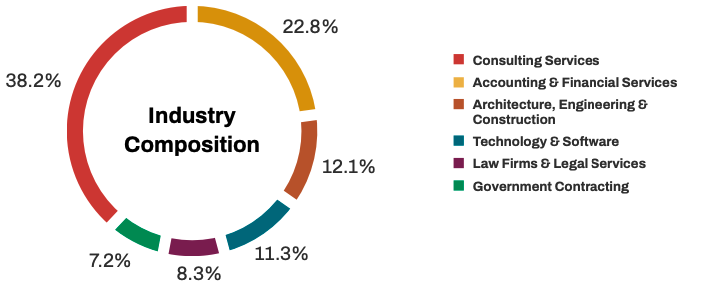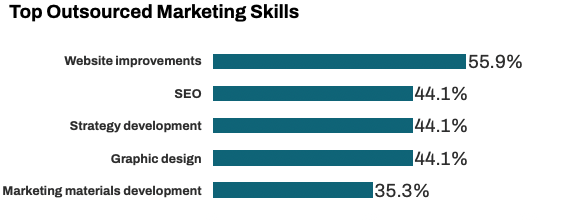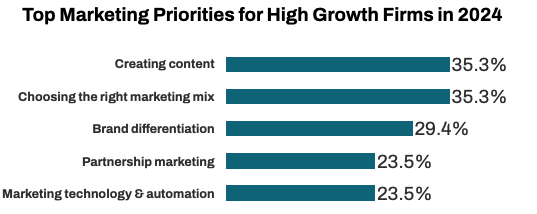Recently, we released the 2024 Technology & Software Edition of Hinge’s annual High Growth Study. This study explores how firms in the industry approach marketing—from strategy to talent acquisition to marketing tools and techniques. More importantly, we look at this data through the lens of High Growth firms. We focus on these high performers because they can provide valuable intelligence for firms that want to understand how to grow faster and be more profitable.
Today, we’d like to share some key takeaways from that research. We hope you find this information useful as you consider your own marketing program. Think of this data as a set of benchmarks against which you can compare your approach to marketing. You can get even more data like this—and practical advice to put it into practice—in the full industry study.
About the Study
122 technology & software firms participated in this ninth edition of the High Growth Study, representing $9.8 billion in combined revenue and more than 50,000 employees.

Participants represented firms of all sizes, and they conducted business in every region of the globe.
In the study, we grouped the participating firms into three categories: High Growth (see definition in the section below), No Growth (those that experienced zero or negative growth), and Average Growth (the rest of the sample).
Get to Know the High Growth Firms
We define High Growth firms as those firms that achieve at least 20% compound annual growth over a three-year evaluation period. We contrast these firms against those that experienced little or no growth over the same time frame. This allows us to identify strategies and practices that are associated with faster growth and higher profits.
This year’s High Growth technology & software firms grew at a median rate of 38.3%—more than three times faster than their Average Growth peers. High Growth firms are also more profitable, enjoying a median profit of almost 24%.

Now, let’s look at four key factors from the research that contribute to these firms’ competitive advantage.
1: High Growth Tech & Software Firms Spend Much Less on Marketing
High Growth firms not only spend less, they spend half as much as their No Growth counterparts. They are investing only 5% of their revenue in marketing (not including compensation), yet they are performing at a significantly higher level. If marketing dollars aren’t the answer, what’s driving their success? We explore a few of the reasons in the factors below.

2: High Growth Firms Know Which Marketing Techniques Work
In the chart below, we see the five marketing techniques used most often by High Growth technology & software firms. Compare this top-five list (the complete list is available in the full industry report) to your own most frequently used marketing activities. Are there any that you don’t do, or don’t do well? Think about whether they might be worth making a bigger part of your program.

Let’s walk through these techniques one by one.
The technique the high performing firms use most often is email marketing. It has been around for decades, but email remains the single most effective way to nurture contacts and leads who are on your list. Some people in your audience are active on social media. Some attend conferences. But they all receive email. And if you acquired their email address in the proper way, they want to hear from you—so long as you have something of value to offer them. This makes email marketing an essential component of a content marketing strategy.
Networking at live events is about as traditional a technique as you get. As long as there have been gatherings of business people, networking has been at play. And it remains relevant today, though its role in a modern marketing program is a bit different. When combined with coordinated online tactics such as social media, email marketing and digital advertising, face-to-face networking becomes even more effective.
High Growth firms invest in high-quality business development materials. If your materials look great and the messages are relevant and clear, they make closing business easier. There’s nothing like an visually engaging pitch deck and a clean, easy-to-follow proposal to seal the deal. They bring your brand into focus.
Top performing firms not only network in person, they engage in equivalent activities on social media. And in most cases, this means LinkedIn. There are so many ways to use the LInkedIn platform—from connecting with promising new prospects to sharing valuable insights and content to reengaging with old clients.
Search engine optimization (SEO) is central to most high-performance marketing programs. If you want to be found by audiences you would otherwise never meet, there is no better way to expand your visibility and reach. It’s not enough to optimize your existing website pages, however. You need to regularly publish new educational content—typically blog posts—to your website. Write your posts around carefully researched keywords that address business issues your clients and prospects care about.
3: They Outsource Specialized Marketing Skills
One way High Growth firms spend less on marketing is by outsourcing many critical marketing functions. While this may sound counterintuitive—after all, outsourcing costs good money—it actually saves dollars in the end while producing superior results.
Think about it. If you were to build a marketing department that’s fully qualified to deliver a modern marketing program, you would need a veritable army of specialists: experts in strategy, design, UX, web development, social media, online advertising, email marketing, SEO, writing, video, and PR, to name just a few. Or you could do what most firms do: Hire a couple of generalists who try to learn as many of these things as they can, quickly get overwhelmed, and struggle to produce tangible benefits.
A better strategy is to have a few key personnel in-house to oversee the entire program and outsource the bulk of the work to true experts. The beauty of this approach is that you pay only for the time required to produce a deliverable. Best of all, because the work is done by true specialists who are up on the latest techniques and use the newest tools, you get far better results faster.
Which techniques do High Growth firms outsource most often? Here’s a list of the top five:

4: High Growth Firms Have Clear Priorities for the Year Ahead
Where are High Growth prioritizing their time and marketing dollars this year? The chart below presents these firms’ top current marketing objectives.

In a tie for first place are creating content and getting the marketing mix right. Creating content, of course, is the foundation of content marketing. When you produce educational content on a regular basis, you create more and more opportunities for people to discover you. And if the content is high quality, relevant and valuable, you begin building a loyal following—people who, when their companies are ready to buy services like yours, will think of you first. Learn to play the long game and you’ll never go back.
Choosing the right marketing mix happens in two ways: learning from experience and actively testing new tools and techniques. Many High Growth firms do both, paying close attention to analytics and results. Of course, if you have access to market intelligence (like this blog post), you may be able to take some shortcuts.
A differentiated brand is the cornerstone of every successful marketing strategy. But for many firms it is a real challenge. If you offer services that are largely similar to your competitors, how do you differentiate your firm? In fact, there are many ways. If you struggle with differentiation, you may want to work with an expert to uncover the best approach for you.
Partnering with key industry players is another way High Growth technology & software firms reach new audiences. This could mean partnering with a technology provider who sends you leads directly. Or it could be a marketing partnership with a company that doesn’t compete with you but targets the same audiences. For instance, a software engineering and design company might partner with a tech-savvy research firm to produce a study on the state of digital transformation.
Finally, marketing software increases the efficiency of your marketing by automating key tasks while giving your deeper insights into your prospects and their buyer journey.
What Now?
Now that you’ve learned a bit about the current state of the technology services marketplace, what do you do with this information? A great place to start is to share it with your marketing and executive teams. Then sit down together and have a frank conversation. Are your marketing priorities and investments in line with the best performing firms in the industry? Or are you a little weak in certain areas? Of your current marketing program, do you know what’s performing well and what isn’t?
Whatever you uncover, think about how you can emulate those firms that are able to grow faster and generate more profits. Look for the low-hanging fruit first—activities that will be relatively easy to implement. Then consider what longer-term investments you need to begin planning for now. Which marketing activities will you keep in-house, and which will you send out to experts?
We hope this information not only gives you plenty to think about, but inspires you to take action. The sooner you start the more quickly you can enjoy the sweet fruits of success. Happy marketing!


